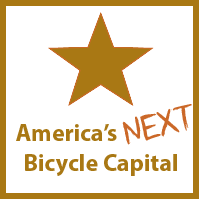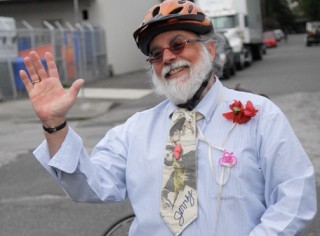Part of our series, America’s Next Bicycle Capital, where we share community voices about the future of biking in Portland. This week’s guest writer is A.J. Zelada, who chaired the Oregon Bicycle and Pedestrian Advisory Committee from 2011 to 2013.
The lifeboat rule needs to be invoked: parents and children first.
I returned from the Netherlands a few weeks ago and I was struck, of course, by how different it was. I admit, I am not so sure it is reproducible here as much as I’ve hawked it in the past. My partner and I bicycled from Bruges, Belgium to Amsterdam up the North Sea coast line but catching Ghent, Delft, Leiden and many other towns along the incredible segregated bike lanes that simply connect everything. [Publisher’s note: Follow Jerry’s adventures here.]
What struck me was that Americans have a missing childhood developmental stage of being an infant, a toddler, and a child on a bike before they get on a bike independently. And even though little Americans are propped up in a baby trailer or behind the rider’s seat, they still miss what parents in Belgium and the Netherlands teach their kids.
The difference is in plain sight: the child is up front on the handlebars or on a cross bar. When the bicyclist enters the traffic pattern, the child bobs and weaves and tilts with the parent. The kid gets imprinted with confrontations on the bike, slow-downs for intersections, people passing, people stopping, all that stuff that experienced riders know after years of riding. All that experience helps develop two key traits for a life of civilized cycling: anticipation and courtesy.
If you spend a year and a half as a preverbal kid riding on a bicycle, that’s something you don’t get later. That’s a hard wiring.
The smoothness of so many people moving by bicycle in all the cities we visited was incredible; the complete opposite of what I’ve experienced on, say, North Williams Avenue here in Portland. Vastly different infrastructural offerings aside, narcissism comes to mind as the most expressed trait here.
Advertisement
As Portland embarks on a major redesign of Williams Avenue, the difference in how we ride here is put into stark relief.
I came back from our European trip even more entrenched in the idea that we need to build each and every bike arterial with parents and children in mind. Every parent with a child should feel safe and able — without reservation — to ride to their nearest grocery store. This will change not only our lives (as we have seen in Europe), it will teach a whole generation how to ride.
But another difference between us and them is what we think of the bicycle. In America the most common question we get asked from people we meet is “How far can you go?” In Europe, we were generally asked, “Where have you been?” This sociological difference meant to me that we Americans are focused on a quantification of existence rather than on the quality of existence.
Williams Avenue will be our most significant bike lane on a major commercial corridor. As the project evolves, I’ll be watching to see whether or not it follows the lifeboat rule. The success of our cycling city, and our children’s lives, depends on it.
Follow Armando “Jerry” Zelada’s many bike adventures at 72km.org.
If you’d like to add your voice to our series, get in touch via email: michael@bikeportland.org.





